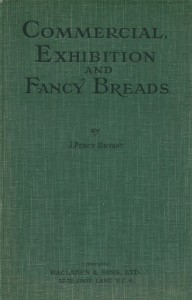- Auteur(s)
- BRYANT J. Percy
- Editeur
- Maclaren & Sons
- Bibliothèque(s)
- Boulangerie
- Parution
- 1924
- ISBN
- NC
- Boutique
- Acheter ce livre »

Résumé
Introduction
Character and properties of wheat and flour
-English, Scotch, Belgian, German, French, Australian, Hungarian, Canadian, American.
Yeast and fermentation
– What yeast is.
– Its reproduction.
– Testing the quality of yeast.
– Gluten and fermentation.
– How it affects the loaf.
– How to store yeast.
Bread improvers.
– Potatoes.
– Cane sugar.
– Glucose.
– Malt flour.
– Malt extract.
– Wheat salts.
Flavour.
– Choice of wheats and flour.
– How to obtain flavour.
– Use of salt.
– Baking.
Texture.
– Its importance in exhibition bread.
– Hand and machine kneading.
– Cause of holes in bread.
– The baking chamber.
Bloom.
– Importance of good brand of yeast.
– Accurately fermented dough.
– Use of agents.
Volume.
– Penalty of excessive volume.
– Crumbiness.
– The effect of strong flour.
– Short and long processes.
– Fours hours’ straight dough recommended.
– Climate conditions.
Moisture.
– The proper percentage.
– The water sprayer.
– Moisture and gluten.
– Result of excess of moisture.
– Boiled bread.
– Six tests.
General appearance.
– Use of the thermometer.
– Moulding cottages, coburgs, « cake » loaves, tins.
– Use of cones.
– Setting of loaves in oven.
Commercial bread.
– Antiquated methods.
– Night shifts.
– Processes for country and town bakers.
– Arriving at the correct temperature.
– 12, 10, 8 and 6 hours’ long process doughs.
– Short process, 5,4,3,2 and 1 hours’ dough.
– Currant bread.
– Wheatmeal bread.
– Milk bread.
– Temperature of oven.
Sponge doughs.
– 12, 10, 8 and 1 1/2 hours’ sponge.
– When the sponge is ready.
– Points for the sponge setter.
Exhibition bread.
– Recipes and instructions for making cottages, open coburgs, tins, pan coburgs, pan cottages, wheatmeal bread, currant bread.
– Utensils and machinery.
– Numbering and packing.
– « Don’ts »
Manipulation of exhibition bread doughs.
– Preparing for the dough.
– Putting the dough through the rollers.
– The right moment to take the dough.
– Everything depends on fermentation.
– Moulding and bashing.
– Proving.
– Making coburgs.
– About ovens.
– Some useful hints.
British Vienna bread.
– The batter sponge system.
– The straight dough system.
– Scalding.
– Proving.
– Making kaisers, shells, crescents, cannons.
– Glazing.
– Baking.
Brown bread.
– Keeping qualities of wheatmeal.
– Wholemeal bread.
– Finely ground meals.
– Malted brown bread.
– Germ bread.
– Bran bread.
– Rye bread.
Fruit bread.
– Mixed fruit bread.
– Speciality fruit bread.
– Bun fruit bread.
– Heavily fruited bread.
– Glazing.
Fancy bread.
– Windsors.
– Jenny Linds.
– Rumpies.
– Coburgs.
– Fancy pans.
– Fancy milk.
Small bread.
– Rasped rolls.
– Bread cakes.
– Batch cakes.
– Dinner rolls.
– Scotch rolls.
– Irish baps.
– Tea cakes.
– Scotch tea cakes.
– Hot plate goods, muffins, crumpets, scotch crumpet, hot plate cakes, milk scones, girdle scones, oat cakes.
– Special bread. – Gluten bread.
– Rusks.
Bakehouse machinery.
– Flour sifter.
– Dough mixers, hand and power.
– Their use and abuse.
– Short and long procecesses by machine.
– Electric power v. gas.
– Petrol and oil engines.
– Combined plants.
– Machinery for confectionery.
– Sponge-beating machine.
– Cake mixers.
– Composite cake plant.
– Fruit cleaning machines.


